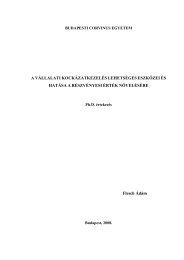Jenei István
Jenei István
Jenei István
You also want an ePaper? Increase the reach of your titles
YUMPU automatically turns print PDFs into web optimized ePapers that Google loves.
<strong>István</strong> <strong>Jenei</strong>: Lean transformation of hospital processes – Structuring foreign and Hungarian experiences,<br />
PhD Dissertation, Corvinus University of Budapest, Doctoral School in Business Administration<br />
The most important events and publications related to the origin and development<br />
of Lean can be seen in Annex 10.1.<br />
1.2. The bases of lean thinking<br />
Lean production has evolved concurrently with the development of Toyota’s<br />
production practice over the years. Surprisingly, the system was not recorded in writing<br />
until 1965: it could only be learned from the practice of the plants (Holweg, 2007). Its<br />
first English description was released in 1977 by Sugimori et al., followed by a series of<br />
works devoted to the components of the system. Researchers, however, sketched several<br />
variants of the system, even if they inspected the same company. Since the lean system<br />
actually denoted Toyota’s continuously developing production (and management)<br />
practice, it is virtually impossible to provide a precise and up-to-date description of the<br />
system. Therefore, researchers and managers must content themselves with developing<br />
their own interpretation of lean management based on past information.<br />
What seems to be generally agreed by the researchers is that lean management has<br />
a dual background: (i) firstly, the totality of tools, methodologies 5 observable in the<br />
production organisation/management practice of the Toyota plants (kanban, SMED,<br />
andon etc.), (ii) secondly, the philosophy and the principles which have led to the<br />
emergence and continuous development of these tools (Shah - Ward, 2003; Hines et al.,<br />
2004). The article by Hines et al. (2004) makes a clean distinction between the lean<br />
production system, meaning the application of the (operational) tools designed for the<br />
development/management of the production area, and the application of lean thinking as<br />
a strategic approach (see Figure 3).<br />
5 I will not give a detailed description of this tools and methodologies in this study. There are several<br />
books available on the topic; it would be even lengthy to list them. In Hungarian there are several<br />
consultant web pages, where exhaustive description can be found. Understanding can be obtained also<br />
from the glossary of the Hungarian translation of Womack – Jones’ book, „Lean Thinking”: James P.<br />
Womack – Daniel T. Jones (2009): Lean szemlélet, HVG Kiadó, Budapest. Of the tools important for this<br />
study I provide a short description where it supports understanding the most.<br />
- 19 -

















